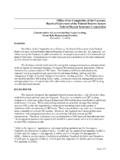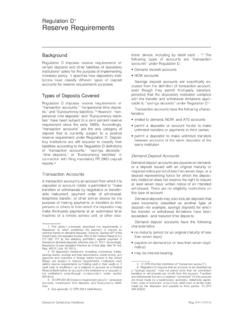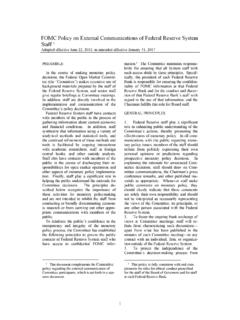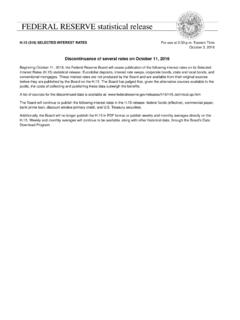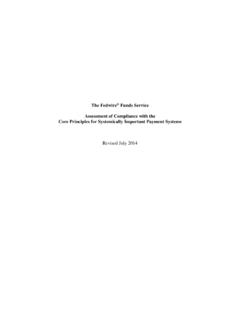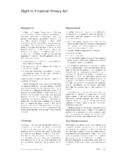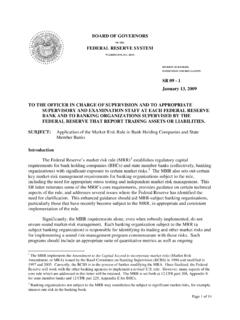Transcription of Comprehensive Capital Analysis and Review 2020 Summary ...
1 Comprehensive Capital Analysisand Review 2020 Summary InstructionsMarch 2020BO A R D O F GO V E R N O R S O F T H E FE D E R A L RE S E R V E SY S T E MComprehensive Capital Analysisand Review 2020 Summary InstructionsMarch 2020BO A R D O F GO V E R N O R S O F T H E FE D E R A L RE S E R V E SY S T E MThis and other Federal Reserve Board reports and publications are available online order copies of Federal Reserve Board publications offered in print,see the Board s Publication Order Form ( )or contact:Printing and FulfillmentMail Stop K1-120 Board of Governors of the Federal Reserve SystemWashington, DC 20551(ph) 202-452-3245(fax) 202-728-5886(email).
2 1 About this Publication .. 1 Key Differences between the CCAR 2020 Instructions and the Previous Year sInstructions .. 1 Overview of CCAR Process .. 3 Communications Related to CCAR .. 4 Mandatory Elements of a Capital Plan .. 5 Assessment of the Expected Uses and Sources of Capital .. 5 Description of All Capital Actions Assumed over the Planning Horizon .. 8 Description of a Firm s Process for Assessing Capital Adequacy .. 9 Expected Changes to Business Plans Affecting Capital Adequacy or Funding .. 9 Organizing Capital Plan Submissions .. 11 Data Supporting a Capital Plan Submission .. 11 CCAR Assessment .. 13 Qualitative Assessment.
3 13 Supervisory Stress Tests .. 14 Federal Reserve s Responses to Planned Capital Actions .. 15 Disclosure of Supervisory Assessments .. 15 Resubmissions .. 15 Execution of Capital Plan and Requests for Additional Distributions .. 16 Appendix A: Scope of CCAR 2020 Qualitative Assessment .. 17 Appendix B: Organizing Capital Plan Submissions .. 19 Capital Plan Narrative .. 19 Capital Plan and FR Y-14A Supporting Documentation .. 21iiiContentsIntroductionThe Federal Reserve s annual Comprehensive CapitalAnalysis and Review (CCAR) is an intensive assess-ment of the Capital adequacy of the largest holding companies (BHCs) and intermedi-ate holding companies of foreign banking organiza-tions (IHCs) (collectively, firms) and the practicesthat these firms use to assess their Capital includes the supervisory and company-runstress tests that are conducted as a part of theBoard s Dodd-Frank Act stress tests (DFAST),2 thesizing of each firm s stress Capital buffer require-ment, and a qualitative assessment of firms capitalplans.
4 The Federal Reserve expects firms to be ableto continue operating and lending to households andbusinesses, even during times of economic and finan-cial market instructions include information about theFederal Reserve s supervisory stress tests and quali-tative assessment of Capital plans submitted in con-nection with this year s CCAR exercise (CCAR2020) by (1) firms subject to the Large InstitutionSupervision Coordination Committee framework(LISCC firms); (2) large and complex firms;3 and(3) large and noncomplex firms,4 which are subjectonly to the supervisory stress tests. See table 1 for alist of firms participating in CCAR 2020 and the ele-ments of the exercise, explained more herein, towhich they are this PublicationThese instructions provide information regardingCCAR 2020, the stress testing and Capital planningcycle that began on January 1, 2020.
5 Similar to theCCAR instructions in previous years, these instruc-tions provide information regarding logistics for a firm s Capital plan submission, expectations regarding the mandatory elements ofa firm s Capital plan, the qualitative assessment of a firm s Capital plan, the supervisory stress tests, the Federal Reserve s response to a firm s capitalplan and planned Capital actions, and public disclosures by the Federal Reserve at theend of the Differences between the CCAR2020 Instructions and the PreviousYear s Instructions Adoption of the stress Capital buffer: The Boardrecently adopted a final rule to establish a firm-specific stress Capital buffer (SCB) requirement,whereby the results of the Federal Reserve s super-visory stress tests and firms planned dividends areused to determine the size of the Capital bufferrequirements to which each of the largest banksare The components and mechanics of1 See 12 CFR ( Capital plan rule), 12 CFR (e)(2)(ii)(stating that an IHC with total consolidated assets of $100 bil-lion or more must comply with 12 CFR in the same man-ner as a BHC).
6 2 Pub. L. No. 111-203, 124 Stat. 1376 (2010); 12 CFR part 252,subpart E; Pub. L. No. 115-174, 132 Stat. 1296 (2018).3 Under the Board s Capital plan rule (12 CFR ), large andcomplex firms are BHCs and IHCs that, as of December 31,2019, (1) have $250 billion or more in average total consolidatedassets, (2) have average total nonbank assets of $75 billion ormore, or (3) are global systemically important bank hold-ing companies. LISCC and large and complex firms shouldconsult the guidance in SR letter 15-18, Federal ReserveSupervisory Assessment of Capital Planning and Positions forLISCC Firms and Large and Complex Firms, December 18,2015, 4 Large and noncomplex firms are BHCs or IHCs that (1) haveaverage total consolidated assets of between $100 billion and$250 billion, (2) have average total nonbank assets of less than$75 billion, and (3) are not global systemically importantbank holding companies.
7 These firms Capital planning capa-bilities are reviewed under a separate firm s SCB requirement is calculated as (1) the differencebetween the firm s starting and minimum projected commonequity tier 1 Capital ratios under the severely adverse scenario inthe supervisory stress test, plus (2) four quarters of plannedcommon stock dividends as a ratio of risk-weighted SCB are described in the final rule. As a resultof certain of those components, the results of thecompany-run and supervisory stress tests will beless comparable this year. Changes as a result of the Board s tailoring rule: InOctober 2019, the Board adopted a final rule thatestablished a revised framework for determiningprudential standards for large domestic and for-eign banks (the tailoring rule).
8 6 A number of thechanges arising from the tailoring rule impactstress testing and are noted below. Impact upon large and noncomplex firms: Cat-egory IV firms (as defined in the tailoring rule)are subject to the supervisory stress tests everytwo years. These firms did not participate in thesupervisory stress tests in 2019 and, therefore,are subject to the supervisory stress tests Additionally, these firms are no longerrequired to conduct company-run stress AOCI opt-out s impact upon stress testing: Underthe tailoring rule, an institution that meets thedefinition of a Category III or Category IVinstitution as of December 31, 2019, is permit-ted to make an election to opt-out of AOCI dur-ing the first quarter of 2020 on the applicablereporting form filed as of March 31, 2020.
9 Forthe purposes of projections in CCAR 2020,these firms should follow the calculation electionthey make in the first quarter of 2020. Capital simplifications: Beginning on April 1,2020, a firm that is not subject to Category I orII standards will be subject to simpler regulatorycapital requirements for certain Capital deduc-tions and updated risk-weights for those the purposes of CCAR 2020, firms subjectto Category III or IV standards should assumethat these Capital calculation changes are ineffect beginning with the second quarter of theplanning horizon. Large and complex firms exempted fromcompany-run stress tests in 2021: Category IIIfirms (as defined in the tailoring rule) must con-duct and disclose their company-run stress testsin even years, including 2020, instead of annu-ally.
10 These firms are still required to submit their6 Prudential Standards for Large Bank Holding Companies, Sav-ings and Loan Holding Companies, and Foreign BankingOrganizations, The tailoring rule establishes fourrisk-based categories for determining the applicability andstringency of certain prudential standards. Those categorieshave not yet been incorporated into the Capital plan rule but arereferred to herein for ease of Prudential Standards. These firms are not subject toCCAR s qualitative assessment but are required to submit capi-tal plans to the Federal Reserve with the Board s action in adopting the tailoringrule, the Federal Reserve extended the deadline for Category IVfirms to submit the Y-14A, except for Schedule C RegulatoryCapital Instruments, until April 5, 1.
